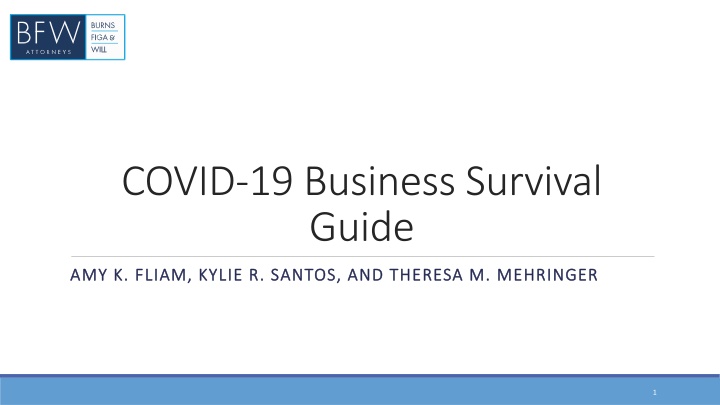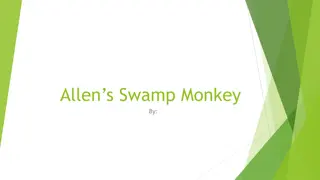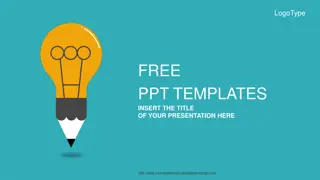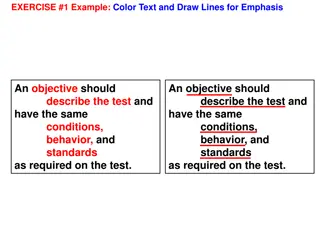
COVID-19 Business Survival Guide for Colorado Companies
Explore the COVID-19 Business Survival Guide tailored for Colorado businesses, covering topics such as deferral benefits for SBA loans, Paycheck Protection Program loans, treatment of outstanding SBA loans under the CARES Act, SBA subsidy of outstanding loans, and details on PPP loans. Get valuable insights to navigate these challenging times.
Download Presentation

Please find below an Image/Link to download the presentation.
The content on the website is provided AS IS for your information and personal use only. It may not be sold, licensed, or shared on other websites without obtaining consent from the author. If you encounter any issues during the download, it is possible that the publisher has removed the file from their server.
You are allowed to download the files provided on this website for personal or commercial use, subject to the condition that they are used lawfully. All files are the property of their respective owners.
The content on the website is provided AS IS for your information and personal use only. It may not be sold, licensed, or shared on other websites without obtaining consent from the author.
E N D
Presentation Transcript
COVID-19 Business Survival Guide AMY K. FLIAM, KYLIE R. SANTOS, AND THERESA M. MEHRINGER AMY K. FLIAM, KYLIE R. SANTOS, AND THERESA M. MEHRINGER 1
Introduction Our Firm serving Colorado businesses for 40 years Roadmap Deferral and Other Benefits for Outstanding SBA loans Paycheck Protection Program Loans (PPP Loans) What is a PPP Loan? Who is eligible? Loan Amount Loan Terms How much will be forgiven? How do you apply? Submit questions during presentation through Zoom to @afliam 2
Treatment of Outstanding SBA Loans Under the CARES Act Sense of Congress: All borrowers are adversely affected by COVID-19, and relief payments by the SBA are appropriate for borrowers. Congress has appropriated $17 billion to the SBA to carry out this relief for certain outstanding SBA loans under the CARES Act. SBA strongly encourages all of its lenders to defer payments on existing loans The SBA shall pay the principal, interest and any associated fees that are owed on eligible loans for the following time periods: With respect to loans made before enactment of the CARES Act and not on deferment, for the 6-month period beginning with the next payment due. With respect to loans made before enactment of the CARES Act and on deferment, for the 6-month period beginning with the next payment due after deferment. With respect to loans made between March 27, 2020 and September 27, 2020 that are not Paycheck Protection Program Loans, for the 6-month period beginning with the first payment due. 3
SBA Subsidy of Outstanding SBA Loans Which loans are eligible for the SBA loan subsidy? Loans guaranteed by the SBA under Section 7(a) of the Small Business Act Includes loans made under the Community Advantage Pilot Program Excludes any Paycheck Protection Program Loans (to be discussed in later slides) Loans guaranteed by the SBA under title V of the Small Business Investment Act of 1958 (investment firms that provide venture capital) Loans made under the Section 7(m) Microloan Program Borrowers looking to take advantage of this subsidy are encouraged to talk directly with their lenders. 4
Paycheck Protection Program Loans (PPP Loans) What are PPP Loans? To encourage small businesses to retain a workforce during the COVID-19 crisis, Congress created PPP loans within the CARES Act to help companies cover payroll and other relevant costs Unique Attributes Less eligibility requirements o No personal guarantees o No collateral Amounts used for certain costs will be fully forgivable 5
Paycheck Protection Program Loans (PPP Loans) Who is eligible for a PPP Loan? Small businesses with fewer than 500 Employees (for businesses in hotel and food services industries, 500 employees at each physical location) 501(c)(3) non-profits with fewer than 500 employees* An individual who operates as a sole proprietor An individual who operates as an independent contractor An individual who is self-employed who regularly carries on trade or business A Tribal business that meets specific SBA size standards A 501(c)(19) Veterans Organization *At this time only 501(c)(3) and 501(c)(19) tax-exempt entities are eligible. 6
Paycheck Protection Program Loans (PPP Loans) Who is eligible for a PPP Loan? For Purposes of determining the number of employees an applicant has, the applicant is considered together with its affiliates There are four tests for affiliation based on ownership or control of the applicant o Ownership (could include negative control) o Stock options, convertible securities, and agreements to merge o Management o Identity of interest Waiver of the affiliation standards for (1) any business in the accommodation and food services industry; (2) any business operating as a franchise that is assigned a franchise identifier code by the SBA; and (3) any business that receives financial assistance from a company licensed under Section 301 of the Small Business Investment Act 7
Paycheck Protection Program Loans (PPP Loans) Affiliation by Ownership Affirmative Control: For determining affiliation based on equity ownership, an applicant is an individual, concern, or entity that owns or has the power to control more than 50 percent of the applicant s voting equity Negative Control: The SBA will deem a minority shareholder to be in control if that individual or entity has the ability, under the applicant s charter, bylaws or shareholder s agreement, to prevent quorum or otherwise block any Board or Shareholder action o If a minority shareholder irrevocably waives or relinquishes any existing rights to block a quorum or prevent Board or shareholder action, the minority shareholder will no longer be an affiliate of the applicant (assuming no other affiliation exists under another test) 8
Paycheck Protection Program Loans (PPP Loans) Affiliation by Common Management If one or more officers, directors, managing members, or general partners who control the applicant s Board of directors or management also controls the board or management of another entity, then the two entities will be considered affiliates If there is common management, all affiliated entities will be considered when determining if an applicant is eligible 9
Paycheck Protection Program Loans (PPP Loans) Loan Amount 2.5xthe borrower s average total monthly payments for payroll costs incurred during either (1) the previous 12 months from the date of the loan or (2) the calendar year 2019 Maximum of $10,000,000 *If you are a seasonal employer, you will use a different time period for your calculation. 10
Paycheck Protection Program Loans (PPP Loans) Included payroll costs : Salary, wage, commission or similar compensation; Payment of cash tip or equivalent Payment for vacation, parental, family, medical or sick leave Allowance for dismissal or separation Payment required for provisions of group health care benefits, including insurance premiums Payment of any retirement benefit Payment of state and local tax assessed on the compensation of employees (not federal tax) Excluded payroll costs : Compensation to an employee in excess of $100,000 Taxes imposed or withheld under chapters 21, 22 or 24 (federal income tax withholding) Any compensation paid to an employee with principal place of residence outside the US Qualified sick leave wages for which a credit is allowed Qualified family leave wages for which a credit is allowed Payments made to independent contractors 11
Paycheck Protection Program Loans (PPP Loans) Examples of calculating loan amount 1. Example 1 No employees make more than $100,000 o Annual payroll costs: $120,000 o Average monthly payroll: $10,000 o Multiply by 2.5 is $25,000 o Maximum loan amount is $25,000 2. Example 2 Some employees make more than $100,000 o Annual payroll costs: $1,500,000 o Subtract compensation in excess of annual salary of $100,000 If there are three employees making $150,000 ($50,000 x 3 = $150,000): 1,500,000 150,000= 1,350,000 o Average monthly qualifying payroll: $112,500 ($1,350,000/12) o Multiply average monthly qualifying payroll by 2.5: $281,250 o Maximum loan amount is $281,250 12
Paycheck Protection Program Loans (PPP Loans) Loan Terms All loans under this program will have the following identical terms: Interest rate of 1% Maturity of 2 years First payment deferred for 6 months interest will still accrue during this time 100% guaranteed by the SBA No collateral required No personal guarantee required No borrower or lender fees payable to the SBA 13
Paycheck Protection Program Loans (PPP Loans) How much of the PPP Loan will be forgiven? Eligible borrowers shall be eligible for forgiveness of the PPP Loan in an amount equal to the sum of the following costs during the 8-week period following the first disbursement of the loan Payroll costs (see slide 11 for what is considered in payroll costs) Payment of interest on covered mortgage Payment on any covered rent obligation (i.e. any rent obligation under a leasing agreement in force before 2/15/2020) Payment on any covered utility (i.e. any payment for a service for the distribution of electricity, gas, water, transportation, telephone or internet access for which service began before 2/15/2020) *forgiveness amount will be reduced if there is any reduction in full-time employees. See Slide 17. 14
Paycheck Protection Program Loans (PPP Loans) How much of the PPP Loan will be forgiven? Limitations on forgiveness Amount forgiven shall not exceed the principal amount of PPP Loan Not more than 25% of the loan forgiveness amount may be attributable to non-payroll costs (i.e. rent or utilities) Forgiveness amount will be reduced by any reduction in full-time workforce (See Slide 17) Reasoning behind 25% non-payroll limitation The core purpose of the statute is to allow borrowers to retain their workforce, and as such, forgiveness amounts should mainly consist of the costs incurred to maintain such workforce 80% of the loan amount is directly attributable to payroll costs due to the fact that loan amounts are 2.5x the average monthly payroll costs 15
Paycheck Protection Program Loans (PPP Loans) Example of 25% limit on non-payroll costs Principal Amount of Loan: $100,000 Amounts Spent During 8-week Period: Payroll Costs: $70,000 Rent: $25,000 Utilities: $5,000 Forgiveness Amounts (forgiveness amount is limited to principal): Payroll Costs: $70,000 Non-Payroll Costs: $25,000 Total Forgiveness Amount: $95,000 Only $25,000 of non-payroll costs can be forgiven ($100,000 x 25%) The $5,000 paid for utilities will not be forgiven *this assumes that there is no reduction of full-time employees. See slide 17 for how to calculate reduction in forgiveness. 16
Paycheck Protection Program Loans (PPP Loans) How much of the PPP Loan will be forgiven? Forgiveness reduction Amount forgiven will be reduced if borrower decreases full-time employee headcount Amount forgiven will also be reduced if borrower decreases salaries and wages by more than 25% for employees that made less than $100,000 annualized in 2019 Borrowers have until June 30, 2020 to restore full-time employment and salary levels for any changes made between February 15, 2020 and April 26, 2020 Forgivable amounts as described on slide 14 Forgivable amounts as described on slide 14 17
Paycheck Protection Program Loans (PPP Loans) How much of the PPP Loan will be forgiven? All borrowers must meticulously document how the proceeds were spent in order to determine the amount of forgiveness Request for forgiveness Borrowers must submit a request for forgiveness with the lender servicing the loan The request must include documentation that verifies the number of full-time employees and pay rates, eligible mortgage, lease and utility obligations The lender shall respond to the request within 60 days No date yet for when employer can request/apply for forgiveness IMPORTANT NOTE: if a small business elects to defer payroll taxes (see slide 22), they will no longer be eligible for forgiveness 18
Paycheck Protection Program Loans (PPP Loans) FORM 2483 How to Apply All applicants must submit SBA Form 2483 and the following payroll documents: Payroll processor records Payroll tax filing For sole proprietors and small businesses, application period opened April 3, 2020 and goes until June 30, 2020 For independent contractors and self-employed individuals, application period opens April 10, 2020 and goes until June 30, 2020 First Come, First Served Basis Borrowers should apply directly with existing SBA lenders 19
Paycheck Protection Program Loans (PPP Loans) SBA Application Form for PPP Loans A signature from a single individual who is authorized to sign on behalf of the borrower is enough to submit the application The applicant must make certain good faith certifications (see certifications and authorizations on Form 2483) 20
Paycheck Protection Program Loans (PPP Loans) SBA Application Form for PPP Loans A single signer must still list all 20% or more owners All 20% or more owners must certify that: they are not presently suspended, debarred, proposed for debarment, declared ineligible or presently involved in bankruptcy They have not obtained an SBA loan or any other federal loan that is currently delinquent or has defaulted in the last 7 years They are not subject to an indictment, criminal information, arraignment, or other means of formal criminal charges , or presently incarcerated or on probation or parole They have not, within the last 5 years, been convicted or pled guilty to a felony 21
Alternatives to PPP Loans Payroll Tax Deferral Businesses can defer federal payroll taxes incurred from March 27, 2020 through December 31, 2020 The first half is deferred until December 31, 2021 and the second half deferred until December 31, 2022 Deferral not forgiveness Economic Injury Disaster Loans No personal guarantee for loans under $200,000 No collateral needed for loans of $25,000 or less Approved EIDL applicants are eligible for a loan advance of $1,000 per employee up to $10,000, and the advance does not have to be repaid 22






















